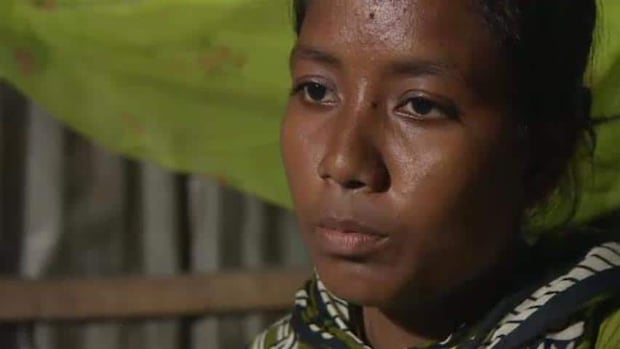Susan Ormiston: Dying for cheap clothes, lessons of the Bangladesh disaster
Still waiting on compensation, reform after Rana Plaza garment factory collapse
It's a mournful place, the remains of Rana Plaza here in Savar, Bangladesh.
Ragged shirts and pants still hang off mounds of concrete pushed to one side when bulldozers razed the site. A pool of rancid rainwater fills the space where five factories used to churn out cheap clothes for Western shoppers.
Watch Susan Ormiston's documentary on the fallout from the Rana Plaza collapse on tonight's The National, 10 p.m. / 10:30 NL.
Nearly eight weeks after the world's worst garment industry disaster, families still press against the barriers, holding up pictures of missing loved ones.
"The disaster shocked us, and made us in many ways ashamed of ourselves," says Mahfuz Anam, editor of the influential The Daily Star newspaper in nearby Dhaka.
Bangladesh's bustling clothes industry has suffered a huge blow, and the country's factory owners and government are trying desperately to rehabilitate their image, and keep their global customers, including those in Canada.
The managing director at one of the companies, Knitwear Group in Dhaka, says international buyers are demanding assurances his factories are safe.
"We are really under pressure. Some buyers are not giving us orders," says Mahmun Khan, whose company supplies lounge pants to Mark's Work Wearhouse and two Quebec-based companies with children's brands.
"Actually they're scared because of Rana Plaza."
Race to the bottom
Over 1,100 people died on April 24 when an illegal, eight-storey building known as Rana Plaza collapsed in a heap of rubble, a direct result of greed and corruption in the Bangladeshi garment trade.
The fault lines in the industry were well known: bribes, lack of rigour when it came to building codes, and a cozy relationship between business owners and the government.
Indeed, a recent study by the Bangladesh University of Engineering and Technology found that 60 per cent of local factories are somehow vulnerable, because of their construction.
"This doesn't mean they will collapse in the next week or month, but it does mean that to leave them unchanged would be irresponsible," says Prof. Mehedi Ansary.

Another culprit here is the race to the bottom for ever-cheaper clothing.
"Before, I was working with Wal-Mart Canada", says Khan at Knitwear Group. "They're giving us very, very low prices. So if I follow that price always then maybe I can't give a good price to the workers."
"Last year if I'm making one sweater at $5.00, this year I'm getting $4.50. If the brands pay us a little more, maybe we can follow more strongly our rules and regulations."
The blame game here is in full flight, and for the obvious reasons. The needle trade employs over 3.5 million workers, and offers up even cheaper labour than China.
Canada's trade with Bangladesh has more than doubled in five years to over $1 billion. Bangladesh is anxiously trying to protect its interests.
As Mahfuz Anam says, "the garment industry came as a surprise boom. We grabbed it, we tried to build on it. We kept cutting on costs; through that process we went into a zone that was dangerous."
The 'cost of cheap'
Today, the poor shantytowns dotting Savar, a Dhaka suburb, are still in mourning.
Young workers came to the city looking for a step up. Even a minimum wage of $37 dollars a month was better than what they could scrape out in their villages.
But so many died. So many more were injured. The "cost of cheap" is becoming unsupportable.
At the Enam Medical College Hospital, dozens of workers are recovering from multiple amputations.

Thirty-year-old Pakihi Begum needs help from her brother to sit on a bedpan. She was trapped in the rubble, a cement pillar on one leg, a dead body on the other. Her rescuers gave her a stark choice.
"They said 'if you want us to save you we have to cut your legs.' I said cut my legs. I don't want my legs, I want to see my two daughters. I want to come out of here."
Both her legs were amputated above the knee before they pulled her out.
Compensation packages are still being negotiated among a combination of payers including the owners, the clothing buyers, the building association, and the government.
Loblaws Canada was one of the buyers. A shipment of pants was days away from delivery when Rana Plaza collapsed.
Loblaws has since signed the Bangladesh Fire and Safety Agreement, which promises tougher audits of structural integrity and a compensation package. But it hasn't said when it will start paying out or how much.
Rana Plaza is a scar on the country's psyche. But it's only one of a catalogue of disasters in the garment trade in recent years.
An art gallery in Dhaka recently launched an exhibition of photos called "Murder not tragedy."
It includes what's become an iconic photo of Rana Plaza. A man and a woman covered in cement dust, seemingly hugging. It's been dubbed '"The final embrace."
The exhibit's curator, Rezaur Rahman, is trying to sharpen the focus.
"This is not a tragedy", he says, "this is a killing. We should make sure the people who are responsible get punished."


